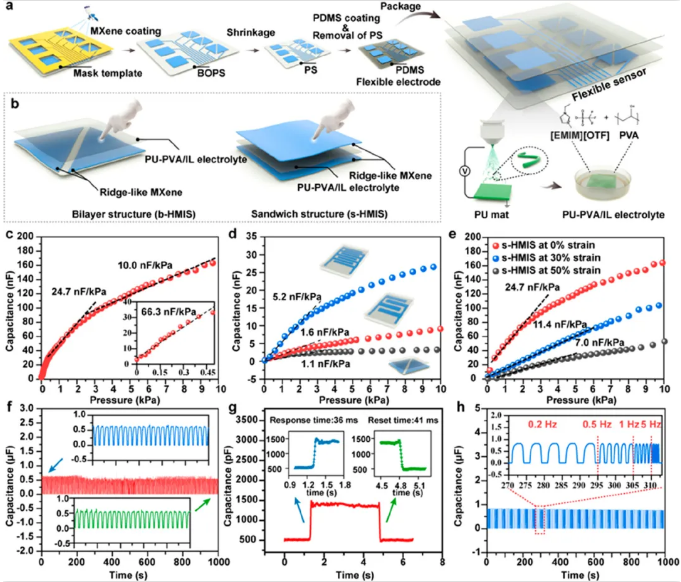
hotline:
17715390137
Tel/Wechat:
18101240246 (Technology)
0512-68565571
Email:mxenes@163.com (Sales Engineer)bkxc.bonnie@gmail.com
Scan the code to follow or search the official account on WeChat:
2D Materials Fronrier After paying attention,
click on the lower right corner to contact us,
Enter enterprise WeChat.
Professional Services Online


1. Article overview
Although Ti3C2Tx MXene nanosheets have high conductivity, it is still a challenge to design highly stretchable MXene electrodes for use in flexible electronic devices. Inspired by the high extensibility of paper-cut patterns, the research team of teachers Hao-Bin Zhang and Zhong-Zhen Yu of Beijing University of Chemical Technology recently reported a bottom-up method, by constructing a wrinkled MXene pattern on a flexible PDMS substrate. Create a layered surface with primary and secondary surface wrinkles. Highly stretchable, conductive polydimethylsiloxane (PDMS)/Ti3C2Tx MXene film can be designed for electromagnetic interference (EMI) shielding and pressure sensing application. Related research work titled "Kirigami-Inspired Highly Stretchable, Conductive, and Hierarchical Ti3C2Tx MXene Films for Efficient Electromagnetic Interference Shielding and Pressure Sensing" was published in the top international journal ACS Nano (IF=14.588), which attracted widespread attention in this field .
Two, graphic guide
(1) During the pre-stretching/release cycle, the self-controlled microcracks generated by uneven deformation in the valley region of the layered film endow the layered PDMS/MXene film with high stretchability (100%). It has stable electrical conductivity in the range of %-100% strain and stable electrical conductivity in 1000 cycles of fatigue measurement.

Figure 1. (a) Schematic diagram of the production of a layered PDMS/MXene film with wrinkled MXene layer.
(B) Photographs of wrinkled PS/MXene and PDMS/MXene films.
(C) SEM images of wrinkled PS/MXene film and (d) wrinkled PDMS/MXene film.
(E) Cross-sectional optical image (top) and SEM (bottom image) of the wrinkled PDMS/MXene film.
(F) The correlation between the wrinkle wavelength and (g) the amplitude of the PDMS/MXene film on the thickness of the MXene layer.

Figure 2. (a) Schematic diagram of the crack evolution of cut-based paper-cut film, crack-based paper-cut film and h-PDMS/MXene film during stretching.
(B) The surface morphology evolution of h-PDMS/MXene film during stretching.
The ridge structure (c) does not have and (d) has 100% tensile strain.

Figure 3. (a) The relationship between the resistance change of the h-PDMS/MXene film and the applied strain.
(B) The relationship between the resistance change of the h-PDMS/MXene film and the maximum applied strain.
(C) Cycle test of h-PDMS/MXene membrane.
(D) Strain time (ST) and resistance time (RT) curves of h-PDMS/MXene film.
(E) S-T and R-T curves of h-PDMS/MXene film without (top) and with a prestress of 10% (bottom).
(F) Graphs of crack length, island length and crack density of h-PDMS/MXene film under different strains.

Figure 4. (a) Cross-sectional SEM images of layered PDMS/MXene films with different ridge heights.
(B) Surface morphology and (c) crack density and length of layered PDMS/MXene films with different ridge heights at a tensile strain of 50%.
(D) The resistance change of PDMS/MXene layered films with different ridge heights under 50% tensile strain.
(E) Through finite element analysis, strain distribution of PDMS, PDMS-G120 and h-PDMS-G120/G260 films.
(F) Through finite element analysis, the strain distribution of h-PDMS-G120/G260 film under different strains.
(2) The stretchable film exhibits a highly stable EMI shielding performance of about 30 dB under a tensile strain of 50%, and by constructing a two-layer film structure, its EMI shielding efficiency is further improved to 103 dB.

Figure 5. (a) Schematic diagram of EMI shielding and Joule heating of h-PDMS/MXene film.
(B) h-PDMS/MXene film, flat PDMS/MXene film and flat PDMS/MXene film are annealed at 140°C and have the same EMI shielding performance of MXene layer thickness.
(C) EMISE diagrams of h-PDMS/MXene films with different MXene layer thicknesses.
(D) Optical photograph of h-PDMS/MXene film used for EMI shielding under tensile deformation.
(E) The relationship between EMISE of h-PDMS/MXene film and applied strain.
(F) The relationship between EMISE and MXene skin thickness of single-layer and double-layer h-PDMS/MXene films.
The Joule heating performance of h-PDMS/MXene film (g) at different voltages and (h) at different MXene thicknesses.
(I) Infrared camera image and photograph of h-PDMS/MXene film under tensile strain.
(J) Thermal imaging camera image of h-PDMS/MXene film under twisting and bending.

Figure 6. (a) illustrates the preparation process of the PDMS/MXene-based touch sensor.
(B) The layered structure of the touch sensor.
(C) Pressure-capacitance response of s-HMIS.
(D) Pressure-capacitance response of b-HMIS with different number of electrode pairs.
(E) The pressure-capacitance response of s-HMIS under different tensile strains.
(F) Durability test of s-HMIS under 90° bending angle.
(G) Response time and reset time of s-HMIS.
(H) Frequency response performance of s-HMIS.
(3) In addition, highly integrated MXene-based electrodes and circuits are manufactured through a stencil printing process, which can be used for highly stretchable and sensitive ionizing sensor arrays with high sensitivity (66.3 nF/kPa), It has excellent dynamic cycle stability in 1000 cycles at different frequencies, and has sensitive pressure monitoring capability under 50% tensile strain.

Figure 7. (a) The application of b-HMIS in pulse monitoring.
(B) The application of s-HMIS in detecting sound vibration, and (c) Short-term FFT (STFT) of the capacitance change signal.
(d) Schematic and (e) photograph of the s-HMIS sensor array, and (f) the corresponding capacitance distribution map.
(G) Schematic diagram of b-HMIS sensor array as a tactile sensor.
(H) Photograph of elbow joint movement and corresponding capacitance distribution map.
3. Thesis information
Kirigami-Inspired Highly Stretchable, Conductive, and Hierarchical Ti3C2Tx MXene Films for Efficient Electromagnetic Interference Shielding and Pressure Sensing
ACS Nano (IF=14.588)
Pub Date: 2021-04-16
https://doi.org/10.1021/acsnano.1c01277
Wei Chen, Liu-Xin Liu, Hao-Bin Zhang*, and Zhong-Zhen Yu*
Beijing Key Laboratory of Advanced Functional Polymer Composites, Beijing University of Chemical Technology, Beijing 100029, China

| Reminder: Beijing Beike New Material Technology Co., Ltd. supplies products only for scientific research, not for humans |
| All rights reserved © 2019 beijing beike new material Technology Co., Ltd 京ICP备16054715-2号 |